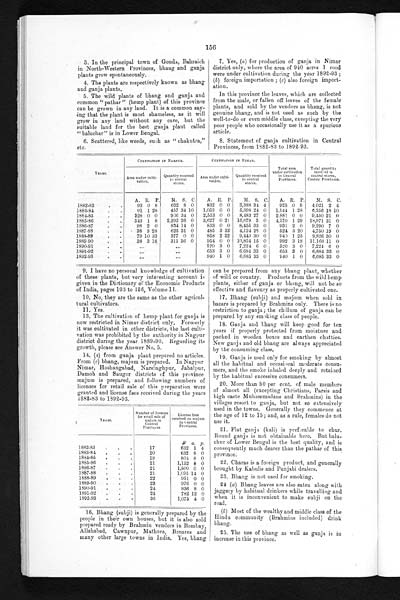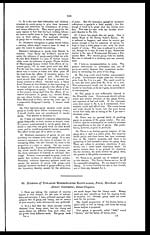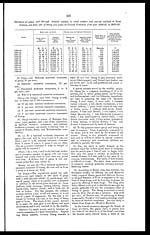Medicine - Drugs > Report of the Indian Hemp Drugs Commission, 1894-1895 > Volume VI > Evidence of Central Provinces witnesses
(174) Page 156
Download files
Individual page:
Thumbnail gallery: Grid view | List view

156
3. In the principal town of Gonda, Bahraich
in North-Western Provinces, bhang and ganja
plants grow spontaneously.
4. The plants are respectively known as bhang
and ganja plants.
5. The wild plants of bhang and ganja and
common "pathar " (hemp plant) of this province
can be grown in any land. It is a common say-
ing that the plant is most shameless, as it will
grow in any land without any care, but the
suitable land for the best ganja plant called
" baluchar" is in Lower Bengal.
6. Scattered, like weeds, such as "chakutra,"
etc.
7. Yes, (a) for production of ganja in Nimar
district only, where the area of 940 acres 1 rood
were under cultivation during the year 1892-93;
(b) foreign importation; (c) also foreign import-
ation.
In this province the leaves, which are collected
from the male, or fallen off leaves of the female
plants, and sold by the vendors as bhang, is not
genuine bhang, and is not used as such by the
well-to-do or even middle class, excepting the very
poor people who occasionally use it as a spurious
article.
8. Statement of ganja cultivation in Central
Provinces, from 1882-83 to 1892.93.
| YEARS. | CULTIVATION IN NAGPUR. | CULTIVATION IN NIMAR. | Total area under cultivation in Central Provinces. |
Total quantity received in central stores, Central Provinces. |
||||||||||||||
| Area under culti- vation. |
Quantity received in central stores. |
Area under culti- vation. |
Quantity received in central stores. |
|||||||||||||||
| A. | R. | P. | M. | S. | C. | A. | R. | P. | M. | S. | C. | A. | R. | P. | M. | S. | C. | |
| 1882-83 | 93 | 0 | 8 | 632 | 8 | 0 | 832 | 0 | 0 | 3,388 | 34 | 4 | 925 | 0 | 8 | 4,021 | 2 | 4 |
| 1883-84 | 91 | 1 | 28 | 457 | 34 | 10 | 1,053 | 0 | 0 | 5,898 | 24 | 0 | 1,144 | 1 | 28 | 6,356 | 18 | 10 |
| 1884-85 | 328 | 0 | 0 | 9,36 | 34 | 0 | 2,553 | 0 | 0 | 8,483 | 27 | 0 | 2,881 | 0 | 0 | 9,450 | 21 | 0 |
| 1885-86 | 543 | 1 | 8 | 2,292 | 26 | 0 | 3,627 | 0 | 21 | 16,679 | 5 | 0 | 4,170 | 1 | 29 | 18,971 | 31 | 0 |
| 1886-87 | 98 | 2 | 0 | 834 | 14 | 0 | 833 | 0 | 0 | 8,455 | 33 | 0 | 931 | 2 | 0 | 9,290 | 7 | 0 |
| 1887-88 | 38 | 3 | 28 | 625 | 31 | 0 | 485 | 3 | 32 | 4,124 | 28 | 0 | 524 | 3 | 20 | 4,750 | 19 | 0 |
| 1888-89 | 79 | 10 | 33 | 377 | 0 | 0 | 858 | 2 | 32 | 9,449 | 30 | 0 | 940 | 1 | 25 | 9,826 | 30 | 0 |
| 1889-90 | 38 | 3 | 18 | 311 | 36 | 0 | 954 | 0 | 0 | 10,854 | 15 | 0 | 992 | 3 | 18 | 11,166 | 11 | 0 |
| 1890-91 | 520 | 3 | 0 | 7,224 | 6 | 0 | 520 | 3 | 0 | 7,224 | 6 | 0 | ||||||
| 1891-92 | 653 | 3 | 0 | 6,684 | 33 | 0 | 653 | 3 | 0 | 6,684 | 33 | 0 | ||||||
| 1892-93 | 940 | 1 | 0 | 6,685 | 33 | 0 | 940 | 1 | 0 | 6,685 | 33 | 0 | ||||||
9. I have no personal knowledge of cultivation
of these plants, but very interesting account is
given in the Dictionary of the Economic Products
of India, pages 103 to 126, Volume II.
10. No, they are the same as the other agricul-
tural cultivators.
11. Yes.
13. The cultivation of hemp plant for ganja is
now restricted in Nimar district only. Formerly
it was cultivated in other districts, the last culti-
vation was prohibited by the authority in Nagpur
district during the year 1889-90, Regarding its
growth, please see Answer No. 5.
14. (a) from ganja plant prepared no articles.
From (c) bhang, majum is prepared. In Nagpur
Nimar, Hoshangabad, Narsinghpur, Jabalpur,
Damoh and Saugor districts of this province
majum is prepared, and following numbers of
licenses for retail sale of this preparation were
granted and license fees received during the years
1882-83 to 1892-93.
| YEARS. | Number of licenses for retail sale of majum in Central Provinces. |
License fees received on majum in Central Provinces. |
||
| R | a. | p. | ||
| 1882-83 | 17 | 632 | 1 | 4 |
| 1883-84 | 20 | 632 | 8 | 0 |
| 1884-85 | 19 | 804 | 8 | 0 |
| 1885-86 | 21 | 1,152 | 8 | 0 |
| 1886-87 | 21 | 1,500 | 0 | 0 |
| 1887-88 | 21 | 1,695 | 14 | 0 |
| 1888-89 | 22 | 951 | 0 | 0 |
| 1889-90 | 23 | 976 | 0 | 0 |
| 1890-91 | 24 | 836 | 8 | 0 |
| 1891-92 | 25 | 782 | 12 | 0 |
| 1892-93 | 36 | 1,075 | 4 | 0 |
16. Bhang (subji) is generally prepared by the
people in their own houses, but it is also sold
prepared ready by Brahmin vendors in Bombay,
Allahabad, Cawnpur, Mathura, Benares and
many other large towns in India, Yes, bhang
can be prepared from any bhang plant, whether
of wild or country. Products from the wild hemp
plants, either of ganja or bhang, will not be so
effective and flavoury as properly cultivated one.
17. Bhang (subji) and majum when sold in
bazars is prepared by Brahmins only. There is no
restriction to ganja; the chillum of ganja can be
prepared by any smoking class of people.
18. Ganja and bhang will keep good for ten
years if properly protected from moisture and
packed in wooden boxes and earthen chatties.
New ganja and old bhang are always appreciated
by the consuming class.
19. Ganja is used only for smoking by almost
all the habitual and occasional moderate consu-
mers, and the smoke inhaled deeply and retained
by the habitual excessive consumers.
20. More than 50 per cent. of male members
of almost all (excepting Christians, Parsis and
high caste Muhammadans and Brahmins) in the
villages resort to ganja, but not so extensively
used in the towns. Generally they commence at
the age of 12 to 15; and, as a rule, females do not
use it.
21. Flat ganja (kali) is preferable to chur.
Round ganja is not obtainable here. But balu-
chur of Lower Bengal is the best quality, and is
consequently much dearer than the pathar of this
province.
22. Charas is a foreign product, and generally
brought by Kabulis and Punjabi dealers.
23. Bhang is not used for smoking.
24 (a) Bhang leaves are also eaten along with
jaggery by habitual drinkers while travelling and
when it is inconvenient to make subji on the
road.
(b) Most of the wealthy and middle class of the
Hindu community (Brahmins included) drink
bhang.
25. The use of bhang as well as ganja is in
increase in this province.
Set display mode to: Large image | Zoom image | Transcription
Images and transcriptions on this page, including medium image downloads, may be used under the Creative Commons Attribution 4.0 International Licence unless otherwise stated. ![]()
| India Papers > Medicine - Drugs > Report of the Indian Hemp Drugs Commission, 1894-1895 > Volume VI > Evidence of Central Provinces witnesses > (174) Page 156 |
|---|
| Permanent URL | https://digital.nls.uk/74909289 |
|---|




